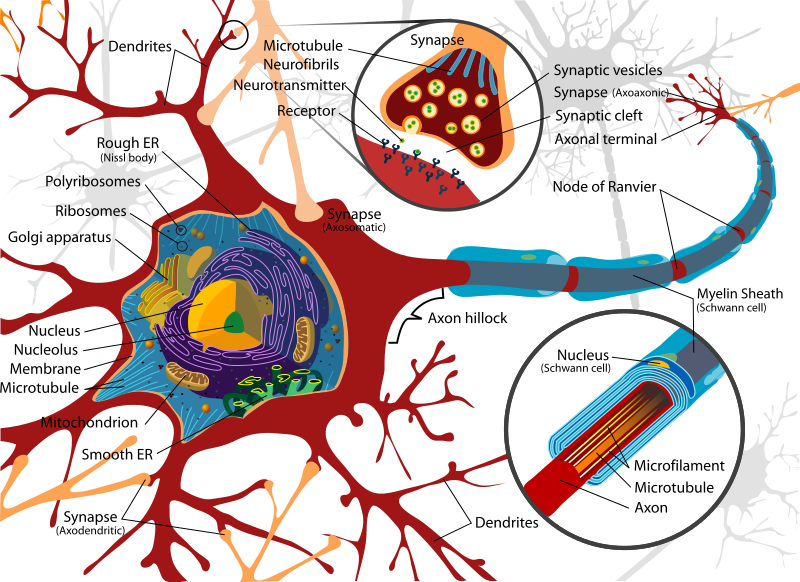When a Neuron Cannot Fire Again
Vocabulary
|
|
|
Neural Firing
Parts of the Neuron
Neurons are our body's nervus cells which make upwardly the nervous system. For a neuron to burn, or communicate with another neuron, information must first be gathered in past the dendrites of the receiving neuron. From at that place, the information passes through the prison cell body to the axon.
| Function of the Neuron | Function |
| Dendrite | Receives data📖 and transfers information technology to the cell torso |
| Cell Body | The neuron's support center❤️ |
| Axon | Passes messages to its terminal branches. The neural impulse goes through the axon and is an electric betoken⚡ |
| Myelin Sheath | A layer of tissue that covers the axon and speeds upwardly neural impulses. Without a myelin sheath, there is a loss of musculus control💪 |
| The Axon'due south Terminal Branches | Laissez passer on chemical messages✉️ to other cells and parts of the body |

Epitome Courtesy of Open Source Textbook
Action Potential
Activity potential must occur for the message to continue to travel down the axon. This only occurs if the neuron's threshold has been met - meaning it has received enough stimulation
🔋
from the original sending neuron. If this threshold is met, the action potential occurs and the message travels down the axon via a process of depolarization. If the threshold is non met, cipher happens. Neurons have an all-or-none response - they either fire or they don't.
-
Basically, the action potential is associated with depolarization. Depolarization is the process that carries the neural impulse through the axon, action potential is what must happen for the process to occur.
At that place are ii types of signals / neurotransmitters:
-
Excitatory -- Pushes neuron's "accelerator"🚦; makes a neuron more probable to reach action potential and fire
-
Inhibitory -- Pushes a neuron's "restriction"🛑; makes information technology less likely for a neuron to reach action potential
Terminal Branches
Once the message has passed through the axon, it reaches the concluding branches. The terminal branches of a neuron contain neurotransmitters which are and then released. These neurotransmitters cross the synaptic gaps betwixt neurons and are gathered in by dendrites of a new neuron, continuing the communication procedure📩
Image Courtesy to Wikipedia
The synapse is where two neurons run across and neurotransmitters are released into it. In that location is both an electrical synapse, which relays quick🐆 messages to another cell, and a chemical synapse, which sends messages slowly🦥 to another prison cell.
Neurotransmitters are stored in vesicles in the axon last. When there is a neural impulse, the vesicle binds with the border of the axon terminal and the neurotransmitters are released into the synaptic cleft.
-
Neurotransmitters that do not detect a habitation on the dendrites of a neuron are absorbed back into the original neuron through a process called reuptake.
Neurotransmitters
Neurotransmitters often act every bit agonists or antagonists in our trunk. An antagonist neurotransmitter binds to the dendrites of a neuron and prevents or blocks🙅 its response. An instance of this is the poison, Botulin. Botulin causes paralysis because information technology blocks the release of acetylcholine, an important neurotransmitter in musculus activity.
Agonists, on the other hand, bind to receptor sites and mimic the furnishings of a specific neurotransmitter. Opiates are an example of an agonist every bit they mimic the effects of endorphins in our torso (which is why they produce a morphine-like issue).
-
Drugs play a trick on our brains into thinking that they are neurotransmitters. As mentioned above, drugs mimic the furnishings of endorphins and so much to the point that our brain stops producing natural endorphins. This is why at that place is such a withdrawal when people terminate trying to take drugs💊. The brain of a long-term drug user but cannot produce something pregnant for your wellness anymore considering of the mode drugs play tricks our encephalon.
Here is a nautical chart of the functions of some key neurotransmitters. It is practiced to memorize this since it is sometimes tested on.
| Neurotransmitter | Role | Examples of Malfunctions |
| Acetylcholine (ACh) | Enables muscle activity, learning, and memory. | With Alzheimer's disease, ACh-producing neurons deteriorate. |
| Dopamine | Influences motion, learning, attention, and emotion. | Crowd --> schizophrenia Undersupply --> tremors and decreased mobility in Parkinson'southward illness |
| Serotonin | Affects mood, hunger, sleep, and arousal. | Undersupply --> depression. Antidepressant drugs raise serotonin levels |
| Norepinephrine | Helps control alertness and arousal | Undersupply can depress mood. |
| GABA | A major inhibitory neurotransmitter | Undersupply --> seizures, tremors, and insomnia. |
| Glutamate | A major excitatory neurotransmitter; involved in retentivity | Crowd --> over stimulates the encephalon --> migraines and seizures (why lots of people avoid MSG in their food) |
| Endorphins | Diminishes the perception of pain and acts as a natural sedative | Undersupply --> can crusade depression, feet and moodiness |
Tabular array and Content Courtesy of Myers' Psychology for AP - 2nd edition
After Firing
After a neuron fires and reaches action potential, information technology goes into its refractory period, where it cannot fire. This period of rest😴 prevents i signal from combining with another.
Then, the neuron reaches the resting potential, where the cell is polarized and set to fire again one time it reaches threshold.
Resources:
Source: https://library.fiveable.me/ap-psych/unit-2/neural-firing/study-guide/oqVfVKPRR7pIEEOGySDW
0 Response to "When a Neuron Cannot Fire Again"
Post a Comment